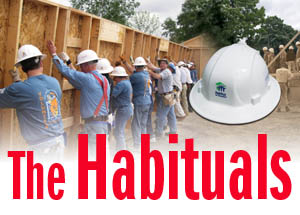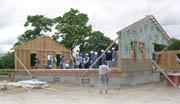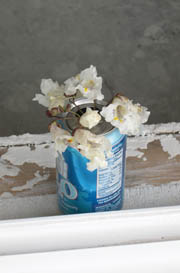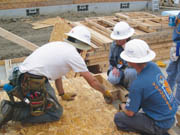
"One of my friends at church said, ‘You should apply for this Habitat program'," says Elfrain Guevara, proud owner of House 20, from the Detroit Jimmy Carter Work Project, that took place this June. "I thought for sure I wouldn't even be considered. But I filled out the application and then some time later I got a call in the morning, just before work. The voice on the other end said, ‘Congratulations: You meet the criteria and you and your family will be receiving a Habitat house.' We were all jumping around the house!"
This is probably a typical response: Habitat candidates don't take such news for granted. In the case for Elfrain and Damaris Guevara, whose home has been the Delray neighborhood of Detroit (close to the Ambassador Bridge), it's a chance for a fresh start in a developing neighborhood. Not that Delray is a crime-infested neighborhood for the 11th largest metropolis in America, it's just one of those areas that has been ignored and neglected by much of the city.
The Guevara's new home, located closer to downtown, is in a developing area called Core City Neighborhoods, which is nestled between the posh areas of Corktown, Mexicantown and the Wayne State University areas. Unlike the mentioned pockets of the city that some view as gentrified, the Core City area will not drive out the existing tenants nor blockade prospective homeowners to look in that area. Real estate remains quite affordable.

How it works
For those unfamiliar with how Habitat partners with families, it can be assured that these homes are not given away. There is an application process, in which a committee screens all applicants to determine eligibility. Once a family has been determined, the applicant must put in 400 hours of what the organization calls "sweat equity." These hours are used for training the homeowners before the build begins, briefing homeowners on construction basics and hands-on work. The balance is used for the actual building of their home. If the hours are not fulfilled, applicants can still make up all the hours by working on another Habitat home. So, the assumption that Habitat builds homes for charity and gives them away is a fallacy.Thirty 1,150-square-foot ranch-style homes were built June 17 through 24. Forty-three BNP Media employees worked for the company-sponsored home, located on 24th St. Beyond the company's miscellaneous staff, joining us were a classic cast of characters from Texas, Iowa, Illinois, Washington State and even Korea.
The first morning of the JCWP, I was greeted by a few of the volunteers who would wind up working the whole week. Smiling, affable and striking a resemblance to a tanned Alec Guinness was Hey Bill, our house leader. Next to him was David Rooke, who resembled a much-older Adam Rich, from TV's "Eight is Enough" fame. And then there's our buddy Seungbong Lee, also known as Happy Guy, straight from Korea and ready to work.

Blessed be
While the remains of the members trickled in, Hey Bill gathered everyone in a circle and instructed everyone to hold hands and each morning a different volunteer would step forward and give a quick devotional before the work commenced. This first day, during prayer at 8:00 a.m., we could tell it would be a long, hot day.The front and back exterior walls were the first to be erected and fastened. It seems every new project was a cause for celebration at Habitat: Elfran did the ceremonious first nail drive into the bottom studs. With most of the 40 people on the site now hammering away, as well as the 29 other homes pretty much working the same schedule and task, the whole neighborhood was a cascade of construction cacophony. Crew leaders Roofing Contractor's Rick Damato and cigar-chewing David Stewart Jr. (and David Stewart Sr. making sure his boys were staying on task) ensured all measurements were exact before the exterior sidewalls were erected.
Our house was next to another that was being built. As Hey Bill had said during the morning group meeting, "Don't look next door," meaning don't compare the progress of one place to another-it can be discouraging or a false sense of accomplishment if you happen to be ahead of or behind another team. Well, as humans we made mental notes of the next-door build and ours. The volunteers next door all had Habitat World Tour shirts, so it was quite a seasoned staff with much Habitat build experience. Although Hey Bill celebrated his 23rd year as a house leader and Damato and Stewart Jr. are now classified Habitat veterans, most of the other staff had minimal experience in construction (including the author, who has slowly attempted to renovate his Queen Anne in a neighborhood within a mile of the Habitat site). So, no one could help comparing the charted growth of our neighbors.

The long day wanes
One snag on that first day was the exterior south wall, which was a hard fit when it was raised."The base plate had a twist in it and that caused it to rise up about 1/2 inch," says Stewart Jr. "The reason it was short is that the front wall was slightly off line.
"The first issue was resolved with a lot of testosterone and lot of 16d nails and a sledge hammer," he continues. "Once we got the wall down, we knew it would be OK when the roof was in place. Ironic but the roof is the true foundation of a lasting house. Without a quality roof, nothing else lasts."
On this first day, after all the interior rooms were fastened and the trusses in place, the sheathing was nailed down. The day was coming to a close and we milked the summer solstice for all its worth. In fact, because each day has a regimented schedule for getting the home built within the six working days, a carefully detailed strategy is broken down for each day (of course). The first day was the hardest.
One of the most memorable moments was when our block leader jumped on the roof and started helping. Then, one of the neighbors from across the street-not at all involved in the JCWP or build-said, "Hey, I work as a carpenter. Do you need a hand?" That's the only time we saw Antoine and the help couldn't have been more pivotal. Great start.
Sunday is the day of rest-for some. For Habitat, it's the day that the specialty trades (i.e., electrical, plumbing, HVAC) came in and set up the ductwork, outlets, copper tubing, etc.
Monday, after Hey Bill gave us the morning prep talk and told us the schedule, Damato began prepping us for the roofing. During this time, several of us began erecting the scaffold. It was a Bil-Jax model and it was the first time I had erected scaffolding. These were really nice units that I coveted. Each set had a retractable leg adjustment, cross bars to secure the sets, platforms that fit in snuggly and the locking mechanisms couldn't have been simpler. One question that I would like answered from a competent person though is when erecting a set over a staircase, and the volume of the stairs doesn't allow one side of the cross bars to be placed, what is the code for setting up then? I gladly report that each scaffold was erected properly, with each unit level. In the staircase incident, we just couldn't get it to work so the set was dissembled and a safer alternative was created.
Damato and Stewart Jr. by now were applying ice guard on one side of the pitch with my buddy Steven Reid and I laying down the material on the other side. After the roof had several layers of shingles, almost a quarter of the volunteers were up there pounding in the GAF-dimensional shingles. I have to give credit to Elfrain up there. These were brutal hot days, peaking low to mid-90 degrees F all week. Up on a roof, with a darker-shade shingle to boot, that temperature rises. However, the future homeowner was up there, endlessly feeding us the shingles and catching the strange yet perfect 12-ounce H2O cans that were being tossed from below to keep the team hydrated. It's a grunt job handling those shingles and much more comfortable and entertaining to be nailing in the shingles but Elfrain was the true team player. He never chased the glory jobs and the guy always had a perpetual smile. He liked how his home was being built.
There's a funny anecdote about Habitat homes and the roofs put on them. When the organization's founder Millard Fuller spoke at a Walls & Ceilings-sponsored event last fall, he mentioned that whenever a hurricane blasts through an area, the homes still with a roof are usually Habitat homes. That's because twice the amount of galvanized nails are driven through the shingles by the volunteers. As a personal observation, my highlight of the week was up there. The pitch was low sloped, the sun felt great and before our eyes, the trail of shingle after shingle was laid. When I first started with this company, I was also an associate editor with Roofing Contractor magazine and since, I've always loved looking at residential roofing. I still keep tabs on what new shingle styles and science the companies are producing.
No mud for us
While we began the roof, those on the ground level began siding the home, flashing the windows and continuous disassembly and assembly of scaffolding.At this point, the home is near halfway done. The roof is on; the siding is being put on; all the insulation batts had been hung (correctly, as the block leader came in and told me and BNP Media employee Amy Lebowsky to redo it after our first attempt); windows flashed and more.
Ironically and frankly quite disappointing, the drywall work was subcontracted out-W&C had wanted to test its muscles and help with the hanging of the board (though Editor Nick Moretti and W&C Publisher Amy Tuttle got to do some sanding). Lafarge North America supplied the wallboard that was used. The work was subcontracted out to Gypsum Partition Systems Enterprises Inc., of Livonia, Mich. The field manager, Matt McMaken, from the little I spoke with him, is a pretty cool guy. He does it all-new construction, renovation, commercial, residential, public institutions, the lot. We talked tools and industry, and business seems to be going good for him. I believe he has been on other Habitat projects and he enjoys the time there. His crew was like ghosts. We have pictures documenting these stealth figures but more or less, they had a very low profile and did a good job working around everyone. The Guevara's have smooth, seamless walls-I tested them with a halogen.
Wednesday, with the build more than half over, we continued to work on the siding. Block leader Jim happened to be riding his golf cart down the street and saw the siding at just the right angle to notice it had been laid out unevenly. Knowing what to do and taking measurements, Rooke instructed Tuttle, Point of Beginning publisher Dan Murfey and myself to strip off the material and reposition it correctly.
Moretti was working this day and brought along his camera to document it (look on www.wconline.com to see a streaming video Web cast of the build). His mission was to interview several of the volunteers, as well as tape the press conference that was late in the morning. He asked me to join him. So, having registered beforehand our press credentials, we were issued big, bright orange name tags, with laminated edges trimmed to sharp, piercing corners. Among us were all the city's top press journalists and cameras. Among the press panel was President Jimmy Carter, interim HFH CEO Paul Leonard, Governor Jennifer Granholm and Detroit Mayor Kwame Kilpatrick. Damato had recommended a list of questions if we did find ourselves in the position.
"Why is the JCWP going to Bombay next year?" I asked.
It's a surreal moment when you have some of the states' strongest powers-not to mention a former president-all gazing directly at you. I am not the most confident of men and I blush easily.
The gentleman, who once ran this country, looked me in the eyes the whole time to say that the project was going there because there was a similar need as there was in Detroit and corrected me that it was actually in Mumbai, India. Additionally, there is work in the tsunami areas that hit Indonesia and Thailand last year so HFH will be there as some relief to those there. As a side note, Carter told us also of how his mother had been in the Peace Corps. 40 years ago and had been stationed in Mumbai, so he thought of traveling there as a sort of sentimental ode to her.
The next day, the rest of the work crew was introduced to Carter. The formalities of a presidential visit are not enjoyable and fall somewhere between a Hollywood film set and the army. Secret Service were everywhere, people driving up on golf carts shouting, "OK, 15 minutes!" and a countdown every five minutes until the photographer got the whole lot of us in a carefully constructed pose. However, it was one of the highlights of the build for the Guevaras. The president and his wife Rosalyn issued a bound King James. Looking around, Carter says, "I know this house is going to be built right," motioning to Hey Bill.
Closing time
The final day of the build is for wrapping projects up. Friday was landscaping and several trees and plants were positioned according to Damaris' approval. However, like most Detroit lots, several years earlier, there had been some kind of property existing on this lot so places we dug were chockfull of brick, concrete and clay. I felt I was east of Eden, like Cain trying to harvest in the land of Nod (see Genesis for those who have no clue what I'm referencing).The closing ceremony, unique to each home, reminded me of jazz: its rhythm interesting, its tone beautiful, its voice unique. Several people got up on the steps with gifts and reflections. The closing segment had a prayer in Español, while the father of Elfrain translated in English. It was a poetic moment, with most of the volunteers having mouths wide open in awe. Then Hey Bill dangled the house keys and said, "And I know you've been waiting for these!"
Every person that's done a Blitz Build will attest that the day is one thing but the social hours are another. I wanted to experience everything within this project so meeting people afterward was a bonus. For one, Hey Bill and Happy Guy were staying at the dorms of Wayne State University, my alumni and the campus my neighbor. I gave these two a ride home a couple times, and got to know them and hear their stories. Hey Bill reflected on some builds he had participated in (out of 23 JCWP as a house leader). One night, we just drove around the streets of Detroit after the day, sharing stories. Happy Guy talked of life in Korea (a local news station broadcast his story the second day of the build). One night, we were in Greektown and saw two guys pull up on choppers.
"Cool bike!" he said.
We walked over to them and he told them that he was from Seoul and that he liked their bikes. We mentioned we were doing Habitat and the men, clearly from a serious and devoted motorcycle gang, asked where. They thanked him for coming to America to do the build and promised they would drive by and check out the homes.
It is memories like these where I particularly found the Habitat experience interesting. More people than I thought were aware of the build and everywhere I went-if there wasn't already Habitat sponsorship-people were very appreciative of what was going on in Core City. The camaraderie was astounding.
To me, and I think others, the week was a spiritual awakening of sorts, the build being a metaphor for relationship building. I got to meet several new people and harvest new friendships. Others there got the opportunity to work closely with their families. Our art director James Hohner and POB editor Leica Brown are about to wed this month; the father-and-son Stewarts team worked for the first time together; our group publisher Tim Fausch and his soon-to-be-wed daughter Jessa enjoyed the whole week together. But most importantly, Elfrain and Damaris worked side-by-side throughout the week, helping build their own palace. My suspicions are they will partake in another Habitat project.
A month-and-a-half later, BNP employee Tricia Presti and I joined house volunteers Diane Palmer, Reid and the Rookes at the house and finished some loose ends. We worked all day and got a chance to reflect on the Blitz Build. Now, there is not much left and the Guevara family will be moving in soon. One task does remain: to install a basketball court for the kids. They love the Pistons.

